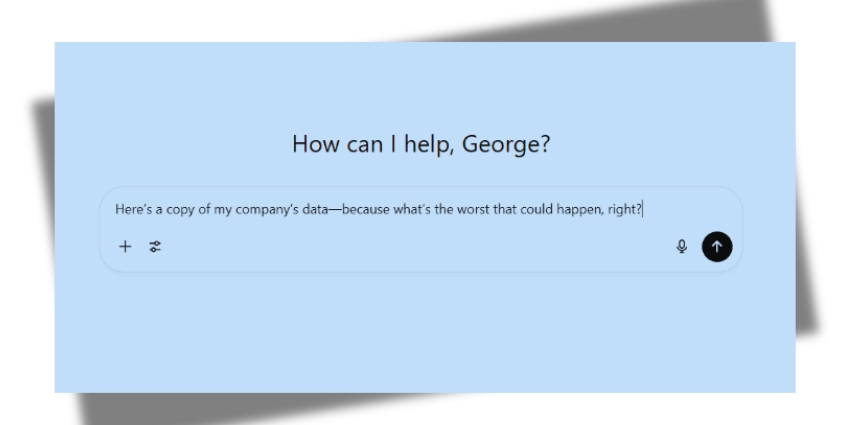I’ve been watching the collaboration technology space evolve for years, but nothing has kept me awake at night quite like what I’m seeing right now. As someone passionate about how unified communications shapes the future of work, I’m witnessing a phenomenon that makes the early days of Shadow IT look like child’s play. If you’re an IT leader, compliance officer, or anyone responsible for enterprise risk management, this conversation is one you can’t afford to ignore.
The statistics are staggering: 73% of knowledge workers are already using AI tools in their daily workflow, yet only 39% of enterprises have formal AI governance policies in place. We’re living through the largest unsanctioned technology adoption wave in corporate history, and it’s happening right under our noses—in our Microsoft Teams calls, Zoom meetings, and everyday collaboration workflows.
We’re living through the largest unsanctioned technology adoption wave in corporate history, and it’s happening right under our noses
The Silent Revolution in Your Conference Rooms
Here’s the uncomfortable truth: while your IT team was busy securing traditional endpoints and network access, your employees started having a very different kind of conversation with artificial intelligence. They’re not just asking ChatGPT about weekend plans anymore. They’re copying entire meeting transcripts, pasting customer data, and uploading proprietary documents to AI platforms that exist completely outside your corporate firewall.
I recently spoke with a compliance director at a Fortune 500 financial services firm who discovered that over 60% of their sales team was routinely feeding client meeting recordings into various AI transcription and summary tools.
We had no visibility into it until we started monitoring UC traffic patterns,” she told me. “The volume of data leaving our collaboration platforms was astronomical, and we had no idea where it was going.
This isn’t isolated to one industry or company size. Shadow AI is proliferating across every sector, from healthcare organizations where nurses are using AI to summarize patient notes, to legal firms where paralegals are feeding case documents into AI research tools. The convenience is undeniable, but the compliance implications are terrifying.
When Productivity Meets Pandora’s Box
The seductive power of AI productivity tools creates a perfect storm for risk. Consider these real-world scenarios I’ve encountered in just the past three months:
A pharmaceutical company discovered their R&D team was using AI to analyze clinical trial data by uploading raw datasets to public AI platforms. The efficiency gains were remarkable—research timelines compressed by 40%—but the HIPAA violations were catastrophic. Patient data that should have remained within secured systems was now scattered across cloud infrastructures they couldn’t control or audit.
A manufacturing giant found their engineering teams were feeding technical specifications and design documents into AI tools to generate reports and proposals. The quality of output was impressive, but they’d inadvertently shared trade secrets with AI models that could potentially be accessed by competitors or foreign entities.
These aren’t stories of rogue employees acting maliciously. These are dedicated professionals trying to do their jobs better, faster, and more efficiently. They’re responding to productivity pressures in a world where AI has become the ultimate workplace assistant. The problem isn’t their intent—it’s the complete absence of guardrails around their actions.
Why Traditional IT Policies Are Failing
The playbook that worked for Shadow IT simply doesn’t apply to Shadow AI. When employees started using Dropbox and Slack without permission, IT departments could block domains, monitor network traffic, and implement endpoint controls. AI presents a fundamentally different challenge because it’s not about applications—it’s about data patterns and human behavior.
Traditional data loss prevention tools are designed to catch files being uploaded or emails being sent. They’re not sophisticated enough to recognize when someone is copying meeting transcript text and pasting it into a browser window. They can’t detect when an employee is verbally dictating confidential information to an AI voice assistant. The attack surface has expanded beyond what conventional security tools can monitor.
Furthermore, the distributed nature of AI tools makes control nearly impossible. Employees aren’t just using ChatGPT—they’re experimenting with Claude, Gemini, Copilot, industry-specific AI tools, browser extensions, mobile apps, and platforms that launch weekly. Each tool has different data handling policies, retention periods, and security standards. Some store conversations permanently, others claim to delete them, and many exist in legal gray areas regarding data ownership and compliance.
The Compliance Time Bomb
For regulated industries, Shadow AI represents an existential threat to compliance frameworks that took decades to establish. GDPR’s “right to be forgotten” becomes meaningless when customer data has been processed by AI models that can’t selectively delete training inputs. HIPAA’s data handling requirements crumble when patient information is processed by AI systems that weren’t designed with healthcare compliance in mind.
Financial services firms face particularly acute challenges. When a wealth advisor feeds client portfolio information into an AI tool to generate investment summaries, they’ve potentially violated Sarbanes-Oxley requirements around data integrity and audit trails. When investment research is processed through unsanctioned AI platforms, it creates regulatory reporting gaps that could trigger massive fines and enforcement actions.
The timing couldn’t be worse. As regulatory bodies worldwide are scrambling to understand AI’s implications, enterprises are creating compliance violations faster than policies can be written. The EU’s AI Act is setting global precedents for AI governance, while the SEC is demanding transparency around AI usage in financial operations. Companies that can’t demonstrate control over their AI usage patterns are setting themselves up for regulatory disasters.
Beyond Banning: A Strategic Response to Shadow AI
The instinctive response to Shadow AI—blocking AI domains and banning AI tools—is both impractical and counterproductive. Employees will simply find workarounds, using personal devices, mobile hotspots, or disguised AI services. Worse, blanket bans eliminate the legitimate productivity benefits of AI while driving even more behavior underground.
The solution requires a fundamental shift in thinking. Instead of treating AI as another application to control, enterprises need to approach it as a data flow to govern. This means implementing AI-aware monitoring systems that can detect unusual data patterns in collaboration platforms, establishing clear guidelines for AI usage across different business functions, and creating sanctioned AI environments that satisfy both productivity needs and compliance requirements.
Leading organizations are already pioneering this approach. They’re deploying specialized monitoring tools that can identify when AI-generated content appears in business communications, implementing role-based AI policies that acknowledge different risk profiles across business functions, and establishing AI governance committees that bring together IT, legal, HR, and business stakeholders.
The Technology Solution: Intelligent AI Governance
This is where innovative platforms like Theta Lake are changing the game. Rather than trying to block AI usage, they’re focused on detecting and governing risky AI behaviors within existing collaboration environments. Their approach recognizes that Shadow AI isn’t going away—it’s going to accelerate—so the focus needs to be on intelligent oversight rather than prohibition.
The platform can identify when AI-generated content appears in Microsoft Teams, Zoom, or other collaboration tools, flagging potential compliance risks in real-time. It can detect unusual data sharing patterns that might indicate unsanctioned AI usage, and it provides the audit trails that compliance teams need to demonstrate governance in regulated environments.
What makes this approach particularly powerful is its integration with existing collaboration workflows. Rather than forcing employees to adopt new tools or processes, it works invisibly within the platforms they already use, providing oversight without disrupting productivity. IT teams get the visibility they need, compliance officers get the audit capabilities they require, and employees can continue leveraging AI tools within appropriate boundaries.
Take a look at our list of the Top UC Security and Compliance Vendors for 2024
Building Your AI Compliance Roadmap
For organizations serious about addressing Shadow AI, the path forward requires both immediate action and long-term strategic planning. The immediate priority is gaining visibility into current AI usage patterns across your collaboration environments. You can’t govern what you can’t see, and most enterprises are currently operating blind to their actual AI exposure.
The next step involves developing AI-specific policies that acknowledge the reality of AI adoption while establishing clear boundaries. These policies need to be role-based, recognizing that a marketing team’s AI needs are different from those of a legal department or clinical research group. They need to be practical, providing clear guidance on what’s acceptable rather than blanket prohibitions that will be ignored.
Long-term success requires building AI governance capabilities into your existing compliance framework. This means updating data classification schemes to account for AI processing, establishing AI-aware audit procedures, and training compliance teams to recognize AI-related risks. It also means partnering with technology providers who understand the unique challenges of AI governance in enterprise environments.
The Future of Work is AI-Augmented—Are You Ready?
The trajectory is clear: AI isn’t going to become less integrated into daily work routines—it’s going to become more pervasive, more sophisticated, and more essential to productivity. The employees using AI tools today aren’t early adopters experimenting with novelty; they’re the advance guard of a workforce transformation that will reshape every industry.
The question isn’t whether your organization will embrace AI—it’s whether you’ll do so with intention and governance, or whether you’ll continue to let Shadow AI proliferate until a compliance crisis forces your hand. The organizations that get ahead of this challenge will gain competitive advantages through responsible AI adoption. Those that remain reactive will find themselves managing increasingly expensive compliance disasters while their competitors pull ahead.
As someone who’s spent years watching collaboration technologies reshape the workplace, I believe we’re at a defining moment. The same unified communications platforms that enabled remote work during the pandemic are now becoming the gateway for AI integration into enterprise workflows. The companies that recognize this shift and implement appropriate governance will position themselves as leaders in the AI-augmented workplace.
The future of work isn’t about choosing between human productivity and compliance requirements—it’s about creating frameworks that enable both. Shadow AI is real, it’s growing, and it’s not going away. The question is: will you govern it proactively, or will it govern you?







